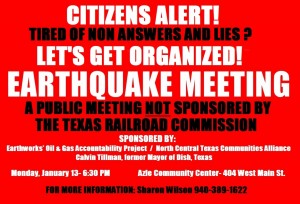Can a Council Whose Majority Voted for the Trinity East Permits Now be Expected to Defend the City’s Denial?
 As you might have heard by now, forlorn natural gas operator Trinity East has sued the City of Dallas for denying the three permits it was seeking to drill along the Trinity River in Northwest Dallas by the Irving border. Claiming breach of contract and even fraud, the company is saying it's owed millions of dollars above and beyond the $19 million it spent on leases for the three sites.
As you might have heard by now, forlorn natural gas operator Trinity East has sued the City of Dallas for denying the three permits it was seeking to drill along the Trinity River in Northwest Dallas by the Irving border. Claiming breach of contract and even fraud, the company is saying it's owed millions of dollars above and beyond the $19 million it spent on leases for the three sites.
Anyone who's seen the filing knows this is a lawsuit with no legs. Yes, Trinity East leased the land, but guarantees about permits being awarded were not part of the deal. Those can't be bought so blatantly. Even Mary Suhm's secret memo un-earthed last February by the Dallas Observer made it clear that her assistance was not a guarantee and "not a legally binding agreement." The leases were one thing. The permits another. Trinity East thought it had the permits in hand when Suhm signed her memo. So did Suhm.
That's why citizens were told in 2012 that Trinity East permits were a "done deal" by sources in City Hall, including Mayor Rawlings, who seems to have known about the Suhm memo before the public did. There was just no way those permits were going to be denied. Suhm and the Mayor were not going to let that happen. That's why they called for the hearing and permit vote two days before Christmas. They thought no one would show and they could wrap it up. So it was a big surprise when the City Plan Commission voted to deny the TE permits. Undeterred, there was suddenly a call for an unprecedented, second "reconsideration vote" by the Plan Commission by the Mayor's representative on the same permits. But Trinity East lost that fight too, by a wider margin, in January of 2013. This time without any public hearing.
When the CPC denial came to the City Council in August of 2013, charter rules demanded it must be overridden by a super majority of 12. The vote to overturn the CPC's denial was 9 to 6, leaving the denial in place, but showing a majority of the current council in favor of granting the permits.
Then the strategy turned to adapting the new drilling ordinance to fit the Trinity East permits. If they couldn't make it through the front door, they could go in the back way. And so City legal staff tried to manipulate the City Plan Commission into carving out exceptions in the new draft ordinance that would allow that. Instead of a 1500-foot setback, they urged 1000 feet with a variance back to 500 feet. That would allow all Trinity East sites. Then they tried to ease the rules on park drilling, and even succeeded to some extent, softening a ban on surface drilling in parks that was part of the old ordinance.
Only Dallas residents working overtime and applying more scrutiny saved the day and got Plan Commission support for a new ordinance that did finally shut the door on all three Trinity East permits. And of course, that's when Trinity East, aided by the entire gas industry, decided to sue.
So you now have the weird situation where the same City Hall that was trying so desperately to win those permits for Trinity East is now being sued by the company for not being conspiratorial enough to subvert the public process. Yesterday, the city issued an statement saying the company's lawsuit lacked merit and, "The city will vigorously defend its right to exercise its regulatory powers to protect public health and safety as well as the environment."
But here's the thing. Since a clear majority of current Dallas City Council members voted for the permits, how much will power is there among this same group to now defend a position they didn't take? And since it was often the Dallas City Attorney's office leading the charge to manipulate the system on Trinity East's behalf, how well do you trust that same crew to "vigorously defend" the outcome they tried so hard to prevent?
Three are some legal principles involving the city's right to control its own zoning decisions which could motivate the city and/or the Texas Municipal League into such a defense. But you have to wonder how much heart they really have for a fight, of which right up until the last vote, they were on the same side as the company now suing them.
To make sure the City doesn't settle with Trinity East, citizens are going to have to persuade the three council members who voted with them for the new ordinance, but against them on the Trinity East permits to change their minds – Jennifer Staubach-Gates, Dwaine Carrawy and Mayor Ralwings.
That won't be easy. Rawlings was making the "I told you so" rounds in the media yesterday. The first sign that they might be serious about defending themselves is whether they'll hire an outside law firm with municipal law experience to represent them. If they put the same people in the City Attorney's office who were working in concert with Trinity to win those permits in charge of this fight, we're doomed. If they hire a competent firm with a reputation for toughness, you'll know they think there might be some points of law worth going to court for.
Longer term, it once again puts a spotlight n the need to elect additional allies of the six council members who've been reliable allies to citizens on this issue. This coming Dallas municipal election cycle in 2015 will see almost half the council seats up for grabs as incumbents are term-limited out. Stay tuned.
Between Now and Friday: Tell Them What They Can Do With Their Smog
 Frustrated that Rick Perry's Texas Commission on Environmental Quality isn't doing enough to end DFW's chronic smog problem, the local "Council Of Governments" has issued a "Request for Information" asking for the public's help in suggesting ways to reduce ozone pollution in North Texas.
Frustrated that Rick Perry's Texas Commission on Environmental Quality isn't doing enough to end DFW's chronic smog problem, the local "Council Of Governments" has issued a "Request for Information" asking for the public's help in suggesting ways to reduce ozone pollution in North Texas.
Please use our Click N' Send E-mail form to make sure they get the message that the public wants:
1) State-of-the-Art pollution controls on huge "point sources" of pollution like the Midlothian cement kilns and East Texas power plants.
2) New pollution control equipment and strategies to reduce the air pollution from the thousands of natural gas facilities mining the Barnett Shale.
3) Inclusion of all trucks and off-road vehicles in the state's vehicle maintenance and inspection program.
You can also add strategies or ideas of your own as well. Just click here, fill out the e-mail and send it in to be counted.
It takes as little as 30 seconds.
BUT YOU ONLY HAVE UNTIL 5 pm FRIDAY, VALENTINE'S DAY.
______________________________________________________________
Rick Perry's TCEQ is so discredited on the matter of DFW smog, local officials usually working in concert with the state agency are now looking elsewhere for help.
Ever since DFW was required to write and submit new clean air plans, The North Central Texas Council of Governments has been the local vehicle used by the state to funnel information, concern, and ideas back and forth.
It was never easy to get Austin's attention or convince the Powers That Be of the need to take bigger clean air measures. It took a decade for Downwinders to get the State to admit that the Midlothian cement plants had a huge impact on local air quality before they were the targets of new controls.
But ever since Rick Perry began running for President in 2010, it's been impossible for Austin toget serious about any DFW clean air plan. For the past four years, TCEQ has claimed that it can reduce air pollution enough by doing nothing.
That strategy has been a dismal failure. New car buying in the middle of the worst economic downturn since the 1930's was the TCEQ clean air plan in 2011. Austin promised that if we just sat back, we'd have the lowest smog levels ever recorded. Instead we had worse air pollution levels than we did five years ago.
This time round, TCEQ is saying a new EPA-mandated low-sulfur gasoline mix in 2017 will be the region's savior for the new clean air plan that's supposed to be successful in reaching the new federal ozone standard of 75 parts per billion in 2018. We're at 87 ppm now – still in violation of the old 1997 standard.
Just watch this new fuel being added to cars and see the ozone numbers drop, TCEQ is saying. No need to put controls on gas facilities, or cement kilns, or power plants. Nothing that would give Rick Perry's opponents on the Right any opportunity to claim he was "anti-bidness."
Even the Council of Governments isn't buying it.
That's why, in their own bureaucratic fashion, this Request for Information that the COG has issued is it's own middle-of-the-road middle finger to TCEQ.
Usually, it would be the state facilitating a discussion of new air pollution control strategies, but since it's obviously not interested, the COG has decided to go its own way. That's how bad things have gotten in Austin – even their most reliable allies in DFW can no longer take them seriously.
It's not clear what will happen to the list of control measures that the Council of Governments is assembling. Some might receive some more official attention, but locals have no authority to write or override Austin's decisions. TCEQ is the only entity that's authorized to submit a new clean air plan to EPA by the June 2015 deadline.
But there are ways to use the useless clean air plans that Austin is submitting. Downwinders' own green cement campaign is a great example.
In 2007, we successfully inserted a voluntary air pollution control strategy into the TCEQ plan revolving around the purchasing of cement from newer cleaner "dry" kilns by local North Texas governments. We then took that "green cement" procurement option and went to Dallas to pass the nation's first green cement ordinance. Then Fort Worth passed it. Then Plano. Then Arlington. Then Denton. Then Dallas County. Then Tarrant County.
Within two years, we had established a de facto moratorium on dirtier "wet kiln" cement within at least a dozen municipal and counties. Combined with federal rule changes, we were able to get all Midlothian wet kilns closed. The last one is being be converted to a dry kiln this year. All while Rick Perry was governor.
The same thing could happen with a good "off-sets" policy for gas facilities if a local city of county could pass a template ordinance showing the way. Currently, most of the gas industry is exempt from being required to "off-set" their air pollution in smoggy "non-attainment" areas like other large industries in DFW. Take away this exemption and you'll see a swift decrease in gas industry air pollution.
It's these kinds of strategies that don't depend on action from Austin that offer the greatest potential for progress this time around.
TCEQ has never written a successful clean air plan for North Texas, and it's not going to start now. But citizens themselves can take their lungs' fate into their own hands and begin to build a system of local measures that can make breathing easier.
______________________________________________________________
CALENDAR AND STATUS REPORT OF DFW'S NEWEST CLEAN AIR PLAN
Reach a 3-year rolling average of no more than 75 ppm of ozone at all 18 DFW area air monitors.
End of an Era: TXI Cement Sold To Martin-Marietta
 In a $2 billion deal, Raleigh, North Carolina-based aggregate and crushed stone manufacturer Martin Marietta Materials (a separate spin-off on the more well-know aerospace conglomerate) bought Dallas' own TXI Cement, which opened its first cement kiln in Midlothian in 1960.
In a $2 billion deal, Raleigh, North Carolina-based aggregate and crushed stone manufacturer Martin Marietta Materials (a separate spin-off on the more well-know aerospace conglomerate) bought Dallas' own TXI Cement, which opened its first cement kiln in Midlothian in 1960.
This year, that kiln, along with the three other obsolete wet kilns at TXI's Midltohian plant that burned hazardous waste for two decades, is due to be demolished, following the company's corporate demise at the hands of the grandson of its founder. And then, the last remnants of the old TXI will be gone for good.
What does the change in ownership mean for breathers in North Texas?
Martin Marietta has owned and operated cement plants around the US in the past, but they'd divested themselves of these prior to 2014. As of now, the TXI cement plants in Texas and California are apparently the only ones the company owns. There's some speculation that Martin-Marietta bought TXI for its aggregate, stone, and concrete facilities in Texas and California, and will soon seek a buyer for the cement plants it inherited, but doesn't really want.
If that's true, the new owners will act as placeholders of the status quo, not investing in big new capital projects, but also trying not to lose any of the value of the assets they now have by running them into the ground. Martin probably won't look favorably upon attempts to bring smog-reducing modern Selective Catalytic Reduction (SCR) technology to TXI via the next clean air plant for DFW, now due in June of 2015. Not only would the plant be among the first to adopt the technology in the US, (even though SCR has been successfully used in European cement kilns for over a decade now), but it would mean new capital investment and a new learning curve.
Swiss-based Holcim Cement, with a huge plant already in Midlothian and a large manufacturing footprint in the US, was rumored to be one of TXI's suitors before the sale was announced. It could be that Holcim, or another well-established player in the cement industry winds up with the actual kilns in the next year. That could complicate the plant's participation in the new clean air in other ways even if new owners are not as intimidated by the demand for new technology
Politically, it'll be interesting to see which Austin lawyers and lobbyists get the business of the new company. Martin-Marietta owns over 40 facilities in Texas already and is represented by it's own crew. Will TXI's law firm and lobbyists survive the buy-out? There are industry lobbyists that will keep the ball rolling no matter what – the Chemical Council, the Aggregate Association, etc. But in Austin, it's all about relationships, and it's hard to say yet how this Martin's buying of TXI changes any of them.
Maybe the place TXI's absence will be felt the most in in the corridors of power in DFW. TXI was proudly headquartered in Dallas. Ralph Rogers, TXI's founder and patriarch was a driving force in local philanthropy, giving millions to public broadcasting (KERA is housed is housed in the "Ralph Rogers Communications Center") and other non-profits. Besides feeing like he was entitled to use PBS's iconic Big Bird to sell the benefits of burning hazardous waste in 50-year-old cement kilns, the non-profit giving Rogers was responsible for made him a known figure on the Dallas Charitable circuit. In turn, this made it hard for the Powers That Be to criticize Roger's company when it became a waste incinerator.
Locally, the establishment played golf with the Rogers' or attended black tie dinners with them, or helped them lift the oversized scissors at ribbon-cutting ceremonies. But that was old Dallas. Hardly of those relationships survived past Ralph Rogers' death in 1997. His son, Robert, failed to maintain that same high-profile locally, and his grandson Jamie seems totally disinterested in the family business or its legacy of charitable giving.
Now, the move of company headquarters from Dallas to Raleigh will complete the disappearance of the once-mighty TXI on the local scene. They'll still be company representatives at functions, but it won't be the guy who can write the big checks, or who the Mayor had a splendid time with last Saturday at the Club.
The company's local political influence has forever been diminished, and that's a good thing for citizens who are fighting the company to get modern controls like SCR. Now, it's just one more corporate entity with a presence in North Texas. A presence that makes it the single largest air polluter in the region. That's the way Dallas and other downwind cities should have viewed the company all along.
No Joke: A Kid, Elvis, and a Rocket Scientist Walk into a Railroad Commission Meeting……
 This is a picture of Robert Caney. Despite achieving the advanced age of 11, he was the youngest member of Tuesday's frakequake bus contingent to the Railroad Commission meeting in Austin.
This is a picture of Robert Caney. Despite achieving the advanced age of 11, he was the youngest member of Tuesday's frakequake bus contingent to the Railroad Commission meeting in Austin.
Robert lives about four miles from the epicenter of the "swarm" of earthquakes that have plagued the residents who live along the convergence of the Parker, Tarrant and Wise county lines northwest of Fort Worth.
You've probably not met many 11-year olds like Robert. He brings new meaning to the word precocious. Without a doubt, he was one of the most articulate people in a RRC meeting room that was packed full of articulate storytellers on Tuesday. And he was also among the most direct among a crowd that doesn't mince its words.
"I have to say that the operations of these wells have to stop now," he lectured RCC Chair (and State Attorney General candidate) Barry Smitherman, and the other two Commissioners. "I want to know how you're going to solve this problem." The kid is alright.
Of course, Robert was media bait, but he had some strong competition in that category. There was Big Bill Hoffman, the Singing Quaker who re-wrote the lyrics to "All Shook Up" and accompanied himself on guitar – in the bus going down to fire up the troops, outside the meeting for the press, and even for his testimony in front of the Commission. Sources believe it to be first such instance of public testimony being sung in the Commission's 123 year history.
Then there was the unintentional comedy team of Stokes and Wood.
Reno (pop 2546) Mayor Lynda Stokes was the first speaker on behalf of the group and she went through the long litany of scientific, well-documented connections between injection wells and induced "earthquakes" that everyone at the Railroad Commission seems to want to not to admit exists. At the end she totaled up the evidence and made the common refrain that "It doesn't take a rocket scientist to see there's a link" between local injection wells and the 30-something quakes the area has experienced since November.
Several speakers later, up pops one Gail Wood, who it turns out IS a former NASA rocket scientist, and states unequivocally that, yep, you really don't have to be one to get this stuff. He brought down the house.
It was the political equivalent of the scene in Annie Hall when Woody Allen, while disputing a fine point of media theorist Marshall McCluen with a friend, is able to conjure up the real-life McCluen out of nowhere to bolster his argument. "You don't need a rocket scientist to know there's a connection. And to prove it, here is one."
Surrounding these speakers were lots and lots of the very kind of folks who probably voted a straight Republican ticket in the last election. The very kind of people that Smitherman is counting on to propel him into higher office. The very kind of people that Milton Rister, Governor Rick Perry's "ideological hit man" who's been imbedded at the RRC as Executive Director, usually counts on to beat back all those treehugging, industry-hating greenies. Only this time they were ones complaining about putting profits before people!
With bolo ties, western shirts, and Stetsons costuming the rhetoric, in many ways it was if Occupy Amarillo had shown up.
And therein lies the problem for the current Administration. These are not the usual suspects that can be dismissed for their ties to "kooky far-out" groups like Environmental Defense Fund and the World Wildlife Federation. These folks are their license-to-carry constituency.
So instead, the RRC has decide that there's just a big mystery here that, by gosh, we just can't seem to solve without more time to study this problem. Smitherman had a go at justifying the agency's inaction by saying the volumes pumped into the two wells closest to the epicenter of the quakes had decreased in the last couple of years – as if the previous years of high-volume pumping had never taken place. If your filling up underground spaces that you didn't know were there and don't know anything much about, hard to say what the tipping point is for setting off, eh Chairman?
But he also left some wiggle room about "faults we didn't know about" that, somehow geology textbooks seem to have discovered. We're making the bold prediction that the seriousness of these "new faults" at the RRC will be directly proportional to the hell that citizens can continue to raise going onto this next election cycle.
in the end, the whole day was an opening shot. By citizens, who invaded the RRC's home turf and had a successful media field day for their cause that keeps up the pressure, and by a desperate RRC shotgunning a load of responses, hoping one or more might be able to hit a target. Protocol was observed. Everyone was more or less polite. There were no citizens thrown out of the meeting this time, No unruly mobs. Yet. Stay tuned.
Media coverage:
Why Downwinders is involved in the Azle Earthquake Fight
 Downwinders at Risk's Jim Schermbeck was one of several speakers at the public organizing meeting on January 13th in Azle, just northwest of Ft. Worth, that saw the creation of a local citizens group to campaign to end the "human-induced" earthquakes plaguing the area for the past several months.
Downwinders at Risk's Jim Schermbeck was one of several speakers at the public organizing meeting on January 13th in Azle, just northwest of Ft. Worth, that saw the creation of a local citizens group to campaign to end the "human-induced" earthquakes plaguing the area for the past several months.
On Tuesday, he'll climb aboard a bus with Azle area residents and go to Austin to speak before the Texas Railroad Commission about the need to cease operations at local fracking waste injection wells until a Unites States Geological Service study on problem in completed in April.
Why is a group whose stated mission is protecting the DFW airshed getting involved with a fight over injections wells and earthquakes?
1. We were asked to. There just aren't that many groups in Texas that employ someone who knows how to parachute into a community and start an effective campaign from scratch. Downwinders is one of them. When we're asked to help a community we haven't been involved in before, as we were in Frisco, and as we are now in Azle, we think about our own past and the lack of any professional resources on the scene in the early 1990's during our fight with the Midlothian cement kilns. If we can be of some help in assisting people who legitimately need it, we usually don't turn them down.
2. Injections wells can be significant sources of air pollution. These facilities can dispose of 100 to 200 million gallons or more of waste every year. Besides fugitive emissions for unloading and storage, some injection wells also have outdoor pools of waste that systematically evaporate pollutants into the air. Injection wells are known to contribute to air quality problems on the ground similar to those experienced by original Downwinders living near the Midlothian cement kilns when they were burning hazardous waste. It turns out there are downwinders surrounding injection wells too. These well emissions are not only a toxic threat to residents living in the immediate vicinity, but they also contribute to regional smog problems too.
3. A win in Azle could led to saner restrictions on locating injection wells. It looks like the recent "swarm" of earthquakes around Azle are centered between two active injection wells. Why are these wells causing problems but others aren't? And why are injection wells being placed in densely populated areas near lots of water wells and infrastructure? DFW Airport saw earthquakes from their injection well and it got closed. Azle residents just want the same respect as American Airlines jets. Are there places in Texas where injections wells shouldn't be located? Yes. Like airports and places where people live near-by. Is it possible to use the Azle fight to better articulate that, regionally or even statewide? Yes. And that would be a good thing.
4. Azle represents an opportunity to organize and win deep behind enemy lines. Azle is in the heart of the Barnett Shale. It's already surrounded by wells and pipelines and compressors, and yet area residents know the shaking that's disrupting their lives is directly linked to fracking itself. This is a revolt of the already-gassed masses, something the western part of the Metromess hasn't seen. It's also true that Azle is prime tea-party GOP territory. Making alliances there helps give lie to the myth that environmental health is only something Democrats and tree-huggers are concerned about. Azle residents can't be easily dismissed as Greenpeace types. You can already see the worry from elected officials over the rise of these new critics. Railroad Commission special meetings. The hiring of a new state seismologist. A new legislative committee on quakes. All in less than a month. This ain't Austin. It's not even Dallas.
That's why we're getting on the bus come Tuesday.
“Did you know there are five carcinogens in Clearasil?”
 That's the question called out from the bathroom by his wife that finally put Ed Brown on the road to making a film about how many synthetic chemicals we're exposed to in our daily lives, often without our knowledge or consent. Brown's final product, "Unacceptable Levels," has its Dallas premiere the evening of January 30th.
That's the question called out from the bathroom by his wife that finally put Ed Brown on the road to making a film about how many synthetic chemicals we're exposed to in our daily lives, often without our knowledge or consent. Brown's final product, "Unacceptable Levels," has its Dallas premiere the evening of January 30th.
At the time, the couple had recently gone through a second miscarriage. "We thought we'd been doing everything right this time – eating organic, staying away from second-hand smoke." They didn't suspect chemical assault by zit cream.
"The Clearasil question" prompted Brown, a former stand-up comedian and CBS Sports staffer, to begin looking at the ingredients of lots of different products we use everyday, including the water we drink. How was it legal to sell carcinogens in something people put on their faces? What was a "safe" dose of a cancer-causing substance, and how did we know it was safe? He found the same pattern time and again – exotic chemicals included for mostly esthetic reasons that had almost no information about how they actually affected human health in the real world, being released on an unsuspecting public to mix and match in ways never predicted by anyone.
At the time, Brown was in the restaurant business. He had never made a film before. But using a camera he'd bought for family use, Brown became a one-man-video-band who went out and interviewed academic and industry experts within one-day's driving distance from his middle-Pennsylvania home about these chemicals. "I edited these clips into a two, three-minute trailer and began showing it to people I knew, who passed it along to people they knew. It eventually caught the attention of producers who wanted to help make the larger film and get it distributed. It was completely D.I.Y."
Brown is particularly concerned about how vulnerable women are to chemical exposure through personal care products and views moms as his film's primary target audience. "I think a lot of us look at a newborn baby and see it as a clean, completely unaffected child, but in fact we're having pre-polluted babies now, born with 200 or more synthetic chemicals in them. Science is telling us what's in them already could harm the health of their great grandchildren. Women are at greatest risk and because they're the child-bearers, but they're also putting successive generations at greater risk."
Changing the way things are done will take time. "It took decades for these chemicals to seep into the marketplace to the extent they have. It'll take decades to get them out." Instead of starting at the top of the bureaucratic food chain, he recommends pursuing change at the local level first. "Go to your neighborhood grocery store or drug store. Ask them to carry non-contaminated alternatives to these products. Ask the local water district why it has to put Fluoride, an industrial waste with no known benefits to dental health, into the water supply. Moms, when they're organized, have a lot of power in the marketplace. General Mills just took GMOs (genetically modified organisms) out of Cheerios because of moms."
When he does talk about wider changes in policy, he notes the attempted reform of the ancient Toxic Substances Control Act of 1976 and adoption of the Precautionary Principle as a gatekeeper for new chemicals. "There's no question that the current testing protocol for new chemicals is deeply flawed, with only a 90-day observation period, compared to multi-generational health effects we're seeing produced through the new field of epigenetics."
Brown spent 2013 picking up awards for "Unacceptable Levels" on the festival circuit and is using 2014 to roll out the film for general release later this year. He likens it to other low-cost first-time video guerrilla efforts like "Supersize Me" that captured wider audiences with word of mouth.
Now with three children, including a new five-month old, Brown has quit his restaurant job and is trying to make a go of it as a full-time filmmaker concentrating on subjects he cares deeply about. "There's no doubt that becoming a parent changes your perspective. These things are not something you think a lot about until you have kids." He's already at work on his next film: "Genetically Modified Movie."
Ed Brown's "Unacceptable Levels" will be shown at 7:30 pm January 30th at the AMC Valley View. Only a handful out of 230 tickets remain. They're $11 each. To buy them, visit the Dallas showing's own website. The film will be followed by a short panel discussion including Downwinders' Jim Schermbeck, Earthworks' Sharon Wilson, Texas Campaign for the Environment's Zac Trahan, and Susan Lee Pollard of the Texas Honeybee Guild.
“It’s impossible to know with no information what level is safe.”
 Some of the very best reporting about the underlying problem that's responsible for the West Virginia water crisis is being done by the local Charleston Gazette.
Some of the very best reporting about the underlying problem that's responsible for the West Virginia water crisis is being done by the local Charleston Gazette.
Following up on their great piece revealing that "MCHM" has exactly one un-reviewed, unpublished 1990 study performed by the chemical manufacturer to say that it's safe to use in the marketplace, on Friday the paper looked closer at the lack of human health effects protocols for chemicals used in the US as a whole.
"They did the best they could with very limited information," said Glenys Webster, an epidemiologist and postdoctoral fellow at Simon Fraser University.
But, Webster said, the entire system the U.S. uses to study and regulate toxic chemicals left decision-makers in West Virginia with a huge vacuum of data and analysis they really needed.
'It's impossible to know with no information what level is safe," Webster said. "I don't think we have the information to make a decision that will satisfy the public."
The paper also quotes toxicologists who explain why the Center for Disease Control's "safe" exposure level for MCHM, which is now being used to give the OK to resume use of Elk River water in Charleston, actually results in the most vulnerable sub-populations, infants and young children, ingesting "closer to that maximum level considered safe by the CDC."
The experts noted that the CDC calculation contained a wide variety of uncertainties that could mean the actual "safe" level is far different from what the agency estimated.
"I think the CDC tripped up when they delayed before issuing the pregnant woman warning," said Jennifer Sass, senior scientist with the Natural Resources Defense Council. "I would recommend that not only pregnant women, but also infants and children avoid the water as long as the chemical contaminants are detected. And, the public needs to know what the detection limit is, so an informed decision can be made about how long to wait after the chemicals are no longer detected."
Experts pointed to a variety of weaknesses in the CDC's approach. Most importantly, they said, it was based on little data. Also, rat studies based on high doses of chemicals can often mask adverse health effects that occur at lower levels.
"It's a very rough calculation," Webster said. "And each step has uncertainty associated with it. It is not an exact science."
Truer words were never spoken. Which is, in part, why 200 people will be going to the Dallas premiere of filmmaker Ed Brown's "Unacceptable Limits" on the evening of January 30th at the AMC 16 at Valley View. There were only 31 seats left as of Sunday afternoon. There's also a panel discussion at the end of the film that includes Downwinders' Jim Schermbeck, along with fracking activist Sharon Wilson, and Texas Campaign for the Environment's Zac Trahan. So please stop by the film's website and buy a ticket for $11.00 to go see a film demonstrating why, whether you live in Irving, Texas or Charleston, West Virginia, you're being chemically assaulted by the same obsolete regulatory system.
Why W. Virginia Crisis Is Perfect Example of Our Lab Rat Status Quo – “Unacceptable Limits” Premier Moves to Larger Theater
 Just to make sure you got the message of Ed Brown's new film about how FUBAR'd the chemical regulatory system is in the US, the twice-convicted felon who runs Freedom Industries in West Virginia arranged for tens of thousands of gallons of a little-known, little understood synthetic substance to spill into the Elk River, cutting off drinking water to 300,000 Charleston area residents.
Just to make sure you got the message of Ed Brown's new film about how FUBAR'd the chemical regulatory system is in the US, the twice-convicted felon who runs Freedom Industries in West Virginia arranged for tens of thousands of gallons of a little-known, little understood synthetic substance to spill into the Elk River, cutting off drinking water to 300,000 Charleston area residents.
So don't let this contamination go to waste – get thee to the online ticket booth and grab some stubs to the January 30th Dallas premiere of "Unacceptable Limits" before it sells out again. They moved it to a bigger theater inside the AMC 16 complex and there are another 50-70 seats now available. The film's producer is showing up and they'll be a short panel discussion afterwards involving Sharon Wilson of Earthworks, Zac Trahan of Texas Campaign for the Environment and Jim Schermbeck of Downwinders at Risk.
And if you read nothing else about the West Virginia situation, please take five minutes to scan this excellent account by the local Charleston Gazette, of how officials are pulling estimates of "safe levels" of the substance MCHM out of their regulatory asses. Why? Because it takes the story away from the god-awful specifics of West Virginia and applies it across the board to explain how no one – not industry, not the US government, not scientists of any sort – has any idea what's a safe exposure to most of the 80,000 chemicals we're coming into contact with in the marketplace. This is exactly Mr. Brown's point in "Unacceptable Limits," and the West Virginia story makes it in spades…..
Tierney explained that the CDC looked for relevant studies of the chemical's health effects but found only one — a 1990 study by Eastman, maker of the product, that was not published in peer-reviewed literature and is considered proprietary.
That study, she said, was the basis for the median lethal dose, or LD50, listed on an Eastman "material safety data sheet," or MSDS that's been circulated by local emergency responders, health officials and the media.
And there you have it. We have one study about the health effects of this chemical. It was done in 1990 – which in environmental health data years, is like the mid-1800's. And it was done by the entity hoping to make a profit from its manufacture. Nothing unseemly there! And then of course we're only talking about fatal doses...
(Based) On that MSDS, the LD50 for Crude MCHM is listed as 825 milligrams per kilogram. This means that, when tested on rats, an 825 milligram dose per kilogram of body weight was enough to kill half the rats.
"The experts then took this number and calculated the uncertainty factors," she wrote. "In this situation there were two. The first uncertainty factor was translating these results from rats to humans. The second uncertainty factor took into account sensitive populations. This includes the elderly, the sick, the immuno-compromised and children, amongst others.
"Uncertainty factors range from 5 to 10 percent," she wrote. "Given the dearth of data and an abundance of caution, both uncertainty factors were rated at 10 percent."
This, Tierney explained, changed the level that would cause death to 8.25 milligrams per kilogram of body weight.
LD50 figures, though, consider only death. They would tell officials nothing about what levels at which chemical exposure would cause other health effects, even serious ones.
To address this, they changed the figure to 1 milligram per kilogram of body weight, which is equal to 1 part per million. It's not clear though — and Tierney did not explain — the scientific basis for the change from 8.25 milligrams per kilogram to 1 milligram per kilogram.
"In this case, it is the entire toxicity profile of a chemical that is unknown. However, predictions are based on what we do know looking at the chemistry and the available data," she said. "In this case, we are dealing with a short-term exposure as opposed to situations in which people have been exposed for weeks to months to years."
Well, at least as far as we know now. The tanks storing the chemical could have been leaking for a long time before they ruptured. The water supply system in Charleston isn't built to catch and filter this kind of chemical, so we'd never know except for a catastrophic accident. In all kinds of ways, we're no different than the rats in the Eastman experiment. No doubt, the catastrophe in Cahrleston will be an epidemiological field day of new research on the health effects of MCHM.
You could throw a dart at nearly all of those 80,000 chemicals on the marketplace and find a similar lack of hard data supporting their benign effect on human health. This is just a more spectacular and acute example.
You might rightly assume that the EPA or FDA or some government agency somewhere is testing these chemicals to make sure they'll be safe when they get rubbed on skin, or inhaled in a lung, or swallowed down a gullet. There is no such agency. No such testing takes place on these chemicals individually, much less in combination with one another, as they would be expected to be experienced in the real world. When there is a study, it is, more often than not, done by the company who wants to make a buck selling the chemical. And even then, the result is limited to finding a less than lethal dose, not understanding how the chemical might disrupt hormones, or the immune system, or have other, more subtle effects we have only come to know about in the last 5-10 years.
Do yourself a favor and get tickets to the January 30th showing of "Unacceptable Risks." Bring your neighbor. Before you find out more than you want to know about the next contaminant gone astray.
It Happened Last Night
 Azle area families are proud to announce the birth of their new grassroots group, and movement, born last night around 8:30 pm, CST.
Azle area families are proud to announce the birth of their new grassroots group, and movement, born last night around 8:30 pm, CST.
It's so new, the 300 or so parents haven't had a chance to name it yet. But it does have a mission: challenging the Barnett Shale status quo.
There's an air of mystery surrounding how these things happen. Many people don't want to be in the room when it actually occurs. Many get nervous. Sometimes it gets messy.
But it's really quite a simple procedure and last night the delivery room was primed for quick and decisive action by two earthquakes in the last 24 hours. No prolonged labor this time. When the call went out to fill the ranks of a local steering committee, bodies shot up out of chairs and spoke their names into the mic for posterity. Male and female, booted and sneakered, grandparents and their grandchildren, Black, Anglo and Hispanic. At the end, approximately 20 volunteers stood in front of the crowd receiving a thankful ovation from their peers.
There are few more poignant moments you can witness in American democracy than the birth of real citizenship.
The newcomer will be taking its first baby steps very soon – at least one bus is being chartered to go to the next Railroad Commission meeting in Austin this next Tuesday, January 21st, and speak to the need of immediate help versus the delay and more study approach of the state. The meeting begins at 9:30am. Details are being worked out now, but the parents say you don't have to be from the Azle area to join the Austin protest. It takes a region to raise a ruckus.
Congratulations to the parents. May their offspring grow up to be strong and smart, and know how to do its job in the shortest amount of time possible. Here's some sample news coverage of the birth:
Because How Can You Go Wrong When Nature Is Your PR Agent?
 Second Azle quake in two days prior to tonight's meeting.
Second Azle quake in two days prior to tonight's meeting.
